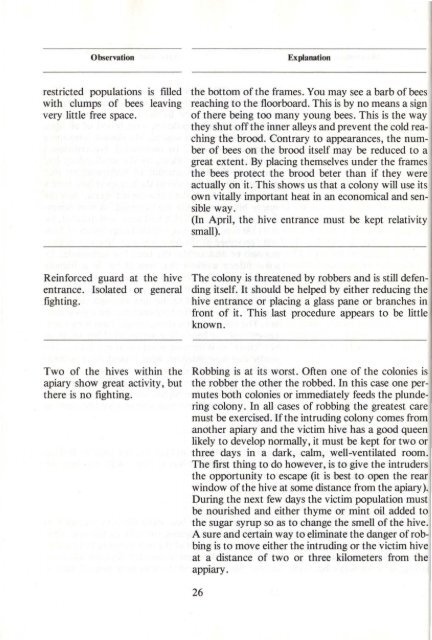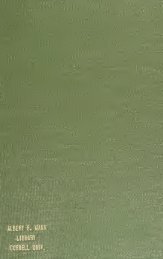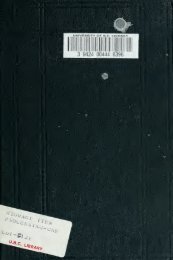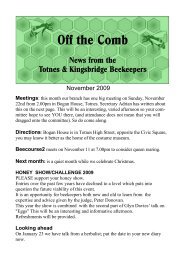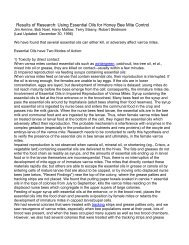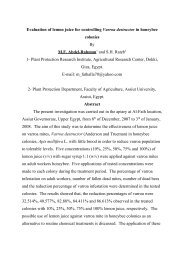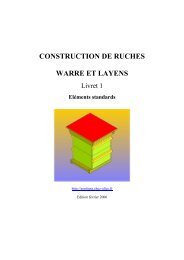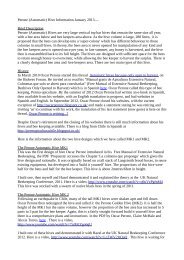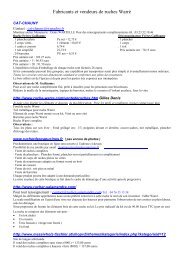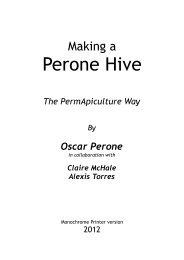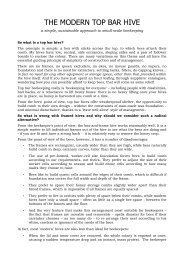You also want an ePaper? Increase the reach of your titles
YUMPU automatically turns print PDFs into web optimized ePapers that Google loves.
Observation<br />
Explanation<br />
restricted populations is filled<br />
with clumps of bees leaving<br />
very little free space.<br />
<strong>the</strong> bottom of <strong>the</strong> frames. You may see a barb of bees<br />
reaching to <strong>the</strong> floorboard. This is by no means a sign<br />
of <strong>the</strong>re being too many young bees. This is <strong>the</strong> way<br />
<strong>the</strong>y shut off <strong>the</strong> inner alleys and prevent <strong>the</strong> cold reaching<br />
<strong>the</strong> brood. Contrary to appearances, <strong>the</strong> number<br />
of bees on <strong>the</strong> brood itself may be reduced to a<br />
great extent. By placing <strong>the</strong>mselves under <strong>the</strong> frames<br />
<strong>the</strong> bees protect <strong>the</strong> brood beter than if <strong>the</strong>y were<br />
actually on it. This shows us that a colony will use its<br />
own vitally important heat in an economical and sensible<br />
way.<br />
(In April, <strong>the</strong> hive entrance must be kept relativity<br />
small).<br />
Reinforced guard at <strong>the</strong> hive<br />
entrance. Isolated or general<br />
fighting.<br />
The colony is threatened by robbers and is still defending<br />
itself. It should be helped by ei<strong>the</strong>r reducing <strong>the</strong><br />
hive entrance or placing a glass pane or branches in<br />
front of it. This last procedure appears to be little<br />
known.<br />
Two of <strong>the</strong> hives within <strong>the</strong><br />
apiary show great activity, but<br />
<strong>the</strong>re is no fighting.<br />
Robbing is at its worst. Often one of <strong>the</strong> colonies is<br />
<strong>the</strong> robber <strong>the</strong> o<strong>the</strong>r <strong>the</strong> robbed. In this case one permutes<br />
both colonies or immediately feeds <strong>the</strong> plundering<br />
colony. In all cases of robbing <strong>the</strong> greatest care<br />
must be exercised. If <strong>the</strong> intruding colony comes from<br />
ano<strong>the</strong>r apiary and <strong>the</strong> victim hive has a good queen<br />
likely to develop normally, it must be kept for two or<br />
three days in a dark, calm, well-ventilated room.<br />
The first thing to do however, is to give <strong>the</strong> intruders<br />
<strong>the</strong> opportunity to escape (it is best to open <strong>the</strong> rear<br />
window of <strong>the</strong> hive at some distance from <strong>the</strong> apiary).<br />
During <strong>the</strong> next few days <strong>the</strong> victim population must<br />
be nourished and ei<strong>the</strong>r thyme or mint oil added to<br />
<strong>the</strong> sugar syrup so as to change <strong>the</strong> smell of <strong>the</strong> hive.<br />
A sure and certain way to eliminate <strong>the</strong> danger of robbing<br />
is to move ei<strong>the</strong>r <strong>the</strong> intruding or <strong>the</strong> victim hive<br />
at a distance of two or three kilometers from <strong>the</strong><br />
appiary.<br />
26


